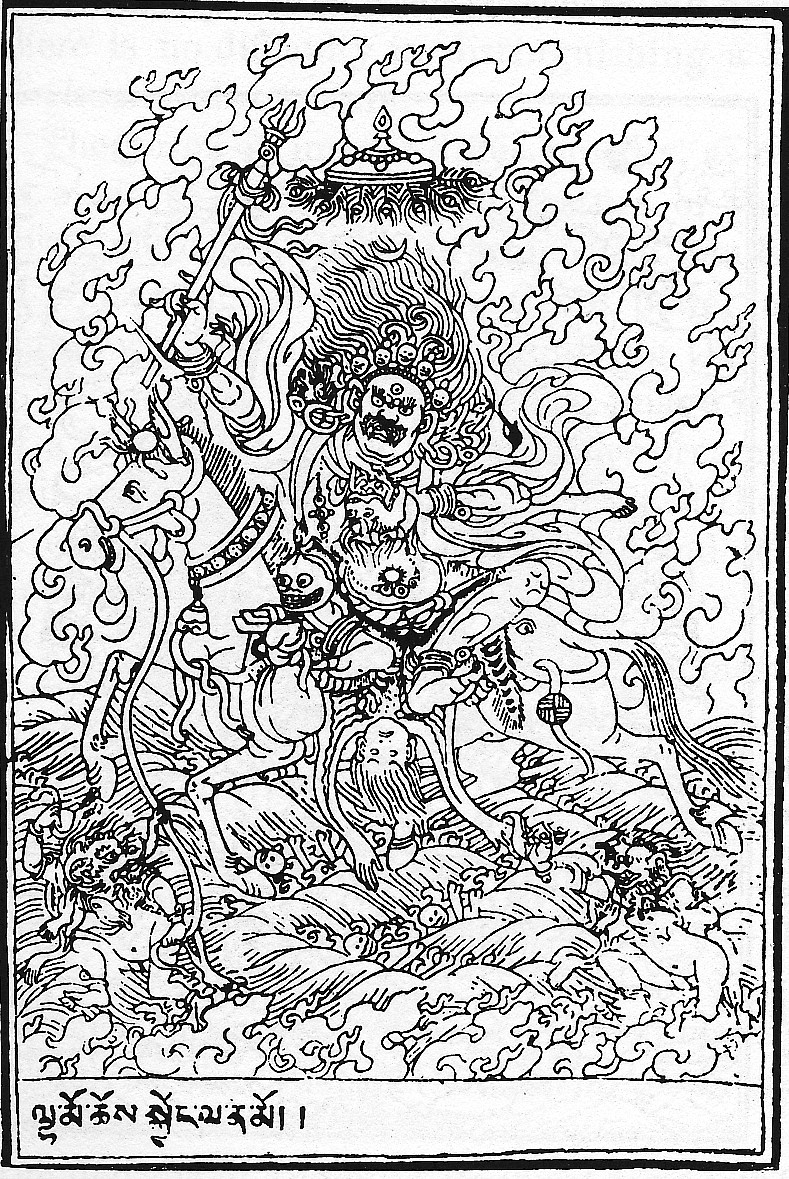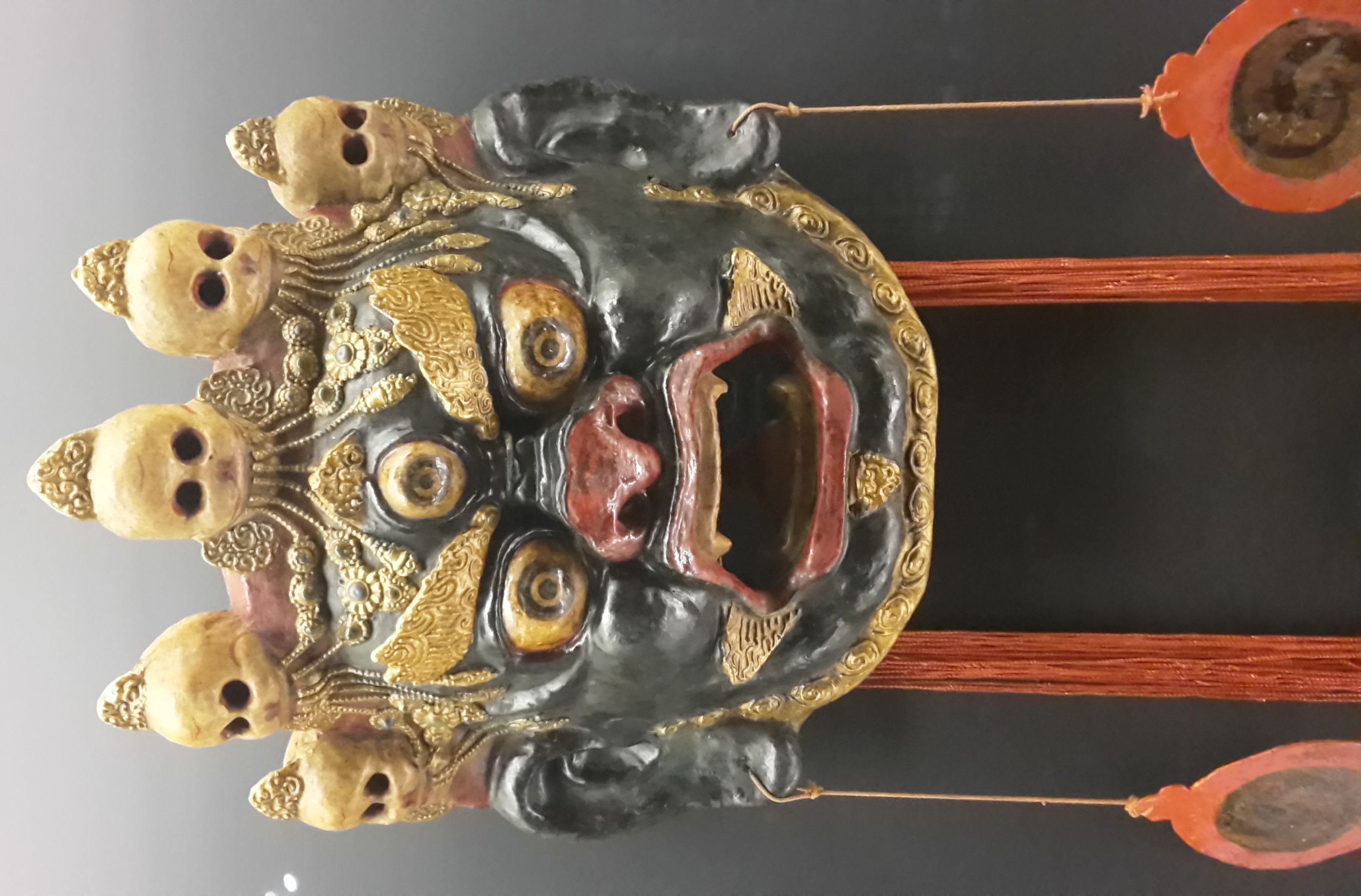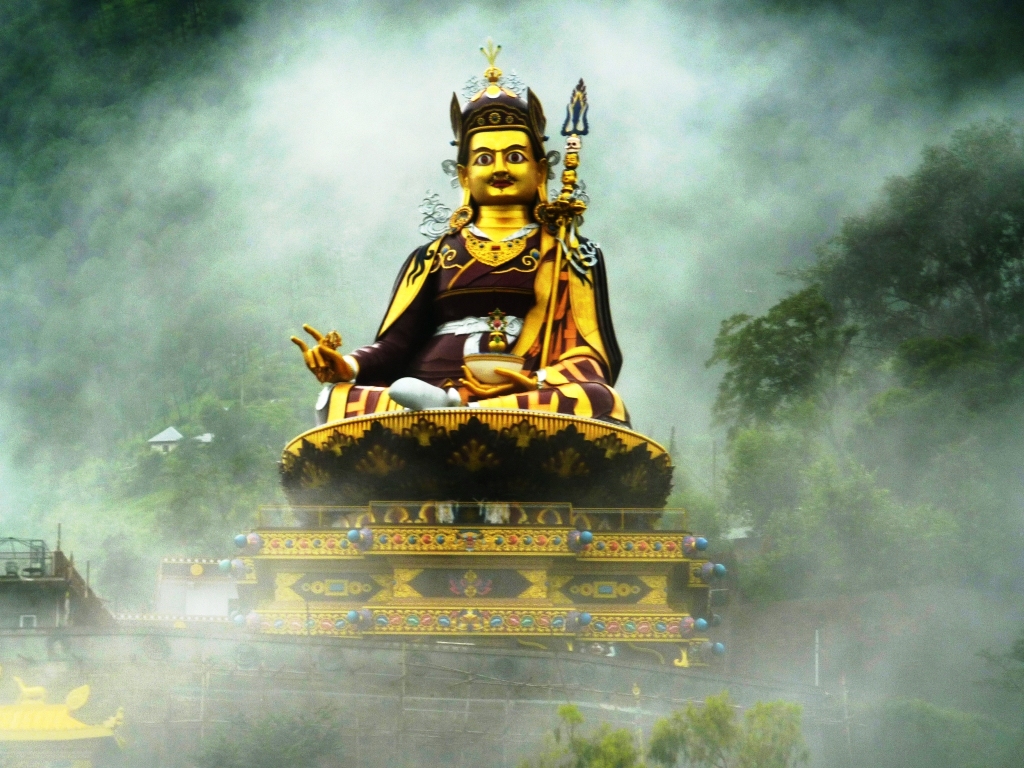|
Tenma Goddesses
The Tenma goddesses are twelve guardian deities in Tibetan Buddhism. In hierarchy, they fall under Palden Lhamo, one of the eight Dharmapala deities. Other times, they are part of the retinue of the Bönpo goddess, Sidpa Gyalmo. Formerly, the 12 Tenma were said to have been local protectors of Tibet before the spread of Buddhism until they came to Padmasambhava's Asura Cave in the Pharping region of Nepal while Padmasambhava was subduing many deities and spirits. Some stories say that the goddesses were hostile to the spread of Buddhism during this time while others said that they refused to give their life essence to Padmasambhava and wanted to keep protecting Tibet. Either ways, Padmasabhava defeated them and bound them to an oath to protect the dharma. In Dharamsala, India, there is a Tenma oracle, for which a young Tibetan woman is the ''kuten'', which literally means, "the physical basis". See also * Nechung Oracle * Trance Trance is a state of semi-consciousness in ... [...More Info...] [...Related Items...] OR: [Wikipedia] [Google] [Baidu] |
Tibetan Buddhism
Tibetan Buddhism is a form of Buddhism practiced in Tibet, Bhutan and Mongolia. It also has a sizable number of adherents in the areas surrounding the Himalayas, including the Indian regions of Ladakh, Gorkhaland Territorial Administration, Darjeeling, Sikkim, and Arunachal Pradesh, as well as in Nepal. Smaller groups of practitioners can be found in Central Asia, some regions of China such as Northeast China, Xinjiang, Inner Mongolia and some regions of Russia, such as Tuva, Buryatia, and Kalmykia. Tibetan Buddhism evolved as a form of Mahayana, Mahāyāna Buddhism stemming from the latest stages of Indian Buddhism (which included many Vajrayana, Vajrayāna elements). It thus preserves many Indian Buddhist Tantra, tantric practices of the Gupta Empire, post-Gupta Medieval India, early medieval period (500–1200 CE), along with numerous native Tibetan developments. In the pre-modern era, Tibetan Buddhism spread outside of Tibet primarily due to the influence of the Mongol Emp ... [...More Info...] [...Related Items...] OR: [Wikipedia] [Google] [Baidu] |
Palden Lhamo
Palden Lhamo ("Glorious Goddess",Volkmann, Rosemarie: "Female Stereotypes in Tibetan Religion and Art: the Genetrix/Progenitress as the Exponent of the Underworld" ''in'' , )Dowman, Keith. (1988). ''The Power-Places of Central Tibet: The Pilgrim's Guide'', p. 260. Routledge & Kegan Paul Ltd., London. (pbk). or Shri Devi is a Vajrayana Buddhist dharmapala who appears in various forms.https://www.himalayanart.org/search/set.cfm?setID=164 Shri Devi Main Page at Himalayan Art Resources She is considered an enlightened being by Tibetan Buddhists. Palden Lhamo is the special dharmapala of the Dalai Lamas, while the three protectors of his Gelug school of Tibetan Buddhism are Yamaraja, Vaisravana, and Mahakala. She is the wrathful deity considered to be the principal protectress of Tibet. Palden Lhamo appears in the retinue of the Obstacle-Removing Mahakala, either as an independent figure or associated to Ekajati, and has been described as "the tutelary deity of Tibet and its ... [...More Info...] [...Related Items...] OR: [Wikipedia] [Google] [Baidu] |
Dharmapala
A ''dharmapāla'' is a type of wrathful god in Buddhism. The name means "''dharma'' protector" in Sanskrit, and the ''dharmapālas'' are also known as the Defenders of the Justice (Dharma), or the Guardians of the Law. There are two kinds of ''dharmapala'', Worldly Guardians (''lokapala'') and Wisdom Protectors (''jnanapala''). Only Wisdom Protectors are enlightened beings. Description A protector of Buddhist dharma is called a ''dharmapala''. They are typically wrathful deities, depicted with terrifying iconography in the Mahayana and tantric traditions of Buddhism. The wrathfulness is intended to depict their willingness to defend and guard Buddhist followers from dangers and enemies. The '' Aṣṭagatyaḥ'' (the eight kinds of nonhuman beings) is one category of ''dharmapālas'', which includes the Garuda, Deva, Naga, Yaksha, Gandharva, Asura, Kinnara, and Mahoraga. In Vajrayana iconography and thangka depictions, ''dharmapala'' are fearsome beings, often with ma ... [...More Info...] [...Related Items...] OR: [Wikipedia] [Google] [Baidu] |
Padmasambhava
Padmasambhava ('Born from a Lotus'), also known as Guru Rinpoche ('Precious Guru'), was a legendary tantric Buddhist Vajracharya, Vajra master from Oddiyana. who fully revealed the Vajrayana in Tibet, circa 8th – 9th centuries... He is considered an emanation or Nirmāṇakāya of Gautama Buddha, Shakyamuni Buddha as foretold by the Buddha himself. According to early Tibetan sources including the ''Testament of Ba'', he came to Tibet in the 8th century and designed Samye Monastery, the first Buddhist monastery in Tibet during the reign of King Trisong Detsen. He, the king, and Khenpo Shantarakshita are also responsible for creating the Tibetan canon, Tibetan Canon through translating all of the Buddha's teachings and their commentaries into the Tibetan language. According to Lewis Doney, while his historical authenticity was questioned by earlier Tibetology, Tibetologists, it is now "cautiously accepted.” Padmasambhava himself was recorded as saying he was an historical per ... [...More Info...] [...Related Items...] OR: [Wikipedia] [Google] [Baidu] |
Dharamsala, Himachal Pradesh
Dharamshala (, ; also spelled Dharamsala) is a town in the Indian state of Himachal Pradesh. It serves as the winter capital of the state and the administrative headquarters of the Kangra district since 1855. The town also hosts the Tibetan Government-in-exile. Dharamshala was a municipal council until 2015, when it was upgraded to a municipal corporation. The town is located in the Kangra Valley, in the shadow of the Dhauladhar range of the Himalayas at an altitude of . References to Dharamshala and its surrounding areas are found in ancient Hindu scriptures such as Rig Veda and Mahabharata. The region was under Mughal influence before it was captured by the Sikh Empire in 1785. The East India Company captured the region for the British following the First Anglo-Sikh War of 1846, from when it became part of the British Indian province of the Punjab. Post Indian Independence in 1947, it remained as a small hill station. In 1960, the Central Tibetan Administration was mo ... [...More Info...] [...Related Items...] OR: [Wikipedia] [Google] [Baidu] |
India
India, officially the Republic of India, is a country in South Asia. It is the List of countries and dependencies by area, seventh-largest country by area; the List of countries by population (United Nations), most populous country since 2023; and, since its independence in 1947, the world's most populous democracy. Bounded by the Indian Ocean on the south, the Arabian Sea on the southwest, and the Bay of Bengal on the southeast, it shares land borders with Pakistan to the west; China, Nepal, and Bhutan to the north; and Bangladesh and Myanmar to the east. In the Indian Ocean, India is near Sri Lanka and the Maldives; its Andaman and Nicobar Islands share a maritime border with Thailand, Myanmar, and Indonesia. Modern humans arrived on the Indian subcontinent from Africa no later than 55,000 years ago., "Y-Chromosome and Mt-DNA data support the colonization of South Asia by modern humans originating in Africa. ... Coalescence dates for most non-European populations averag ... [...More Info...] [...Related Items...] OR: [Wikipedia] [Google] [Baidu] |
Oracle
An oracle is a person or thing considered to provide insight, wise counsel or prophetic predictions, most notably including precognition of the future, inspired by deities. If done through occultic means, it is a form of divination. Description The word ''oracle'' comes from the Latin verb ''ōrāre'', "to speak" and properly refers to the priest or priestess uttering the prediction. In extended use, ''oracle'' may also refer to the ''site of the oracle'', and the oracular utterances themselves, are called ''khrēsmoí'' (χρησμοί) in Greek. Oracles were thought to be portals through which the gods spoke directly to people. In this sense, they were different from seers (''manteis'', μάντεις) who interpreted signs sent by the gods through bird signs, animal entrails, and other various methods.Flower, Michael Attyah. ''The Seer in Ancient Greece.'' Berkeley: University of California Press, 2008. The most important oracles of Greek antiquity were Pythia (priestes ... [...More Info...] [...Related Items...] OR: [Wikipedia] [Google] [Baidu] |
Nechung Oracle
The Nechung Oracle () is the personal oracle of the Dalai Lama since the second Dalai Lama. The Medium (spirituality), medium currently resides in Nechung, Nechung Monastery established by the Dalai Lama in Dharamsala, Himachal Pradesh, Dharamsala, India. The Nechung Oracle was the designated head of the Nechung monastery in Tibet.Pearlman, Ellen (2002). ''Tibetan Sacred Dance: a journey into the religious and folk traditions''. Rochester, Vermont, USA: Inner Traditions. , p.94 History In Tibet and throughout the greater Himalayan region, oracles have played, and continue to play, an important part in revelation, religion, doctrine, and prophecy. In Tibet, the Nechung Oracle and other oracles on occasion, have also played principal roles assisting governmental decision-making and providing intelligence on pressing matters of Sovereign state, state, and perhaps most importantly aid in the provision of security for the 14th Dalai Lama of Tibet. There are a number of oracular ... [...More Info...] [...Related Items...] OR: [Wikipedia] [Google] [Baidu] |
Trance
Trance is a state of semi-consciousness in which a person is not self-aware and is either altogether unresponsive to external stimuli (but nevertheless capable of pursuing and realizing an aim) or is selectively responsive in following the directions of the person (if any) who has induced the trance. Trance states may occur involuntarily and unbidden. The term ''trance'' may be associated with hypnosis, meditation, magic, flow, prayer, psychedelic drugs, and altered states of consciousness. Etymology Trance in its modern meaning comes from an earlier meaning of "a dazed, half-conscious or insensible condition or state of fear", via the Old French ''transe'' "fear of evil", from the -4; we might wonder whether there's a point at which it's appropriate to talk of the beginnings of French, that is, when it wa ... ''transe'' "fear of evil", from the Latin ''transīre'' "to cross", "pass over". Working models Wier, in his 1995 book, ''Trance: from magic to technology'', de ... [...More Info...] [...Related Items...] OR: [Wikipedia] [Google] [Baidu] |
Buddhist Goddesses
Buddhism, also known as Buddhadharma and Dharmavinaya, is an Indian religion and philosophical tradition based on teachings attributed to the Buddha, a wandering teacher who lived in the 6th or 5th century BCE. It is the world's fourth-largest religion, with about 500 million followers, known as Buddhists, who comprise four percent of the global population. It arose in the eastern Gangetic plain as a movement in the 5th century BCE, and gradually spread throughout much of Asia. Buddhism has subsequently played a major role in Asian culture and spirituality, eventually spreading to the West in the 20th century. According to tradition, the Buddha instructed his followers in a path of development which leads to awakening and full liberation from '' dukkha'' (). He regarded this path as a Middle Way between extremes such as asceticism or sensual indulgence. Teaching that ''dukkha'' arises alongside attachment or clinging, the Buddha advised meditation practices and ... [...More Info...] [...Related Items...] OR: [Wikipedia] [Google] [Baidu] |
Gelug
file:DalaiLama0054 tiny.jpg, 240px, 14th Dalai Lama, The 14th Dalai Lama (center), the most influential figure of the contemporary Gelug tradition, at the 2003 Kalachakra ceremony, Bodh Gaya, Bodhgaya (India) The Gelug (, also Geluk; 'virtuous')Kay, David N. (2007). ''Tibetan and Zen Buddhism in Britain: Transplantation, Development and Adaptation,'' p. 39. Routledge. is the newest of the four major schools of Tibetan Buddhism. It was founded by Je Tsongkhapa (1357–1419), a Tibetan people, Tibetan philosopher, Vajrayana, tantric yogi and lama and further expanded and developed by his disciples (such as Khedrup Gelek Pelzang, 1st Panchen Lama, Khedrup Je, Gyaltsab Je, Gyaltsap Je, Dulzin Drakpa Gyaltsen, and 1st Dalai Lama, Gendün Drubpa). The Gelug school is alternatively known as Kadam (''bKa’-gdams gsar-pa''), since it sees itself as a continuation of the Kadam (Tibetan Buddhism), Kadam tradition of Atiśa, Atisha (c. 11th century). The school of New Kadam, or New Kadampa ... [...More Info...] [...Related Items...] OR: [Wikipedia] [Google] [Baidu] |
Female Buddhas And Supernatural Beings
An organism's sex is female (symbol: ♀) if it produces the ovum (egg cell), the type of gamete (sex cell) that fuses with the male gamete (sperm cell) during sexual reproduction. A female has larger gametes than a male. Females and males are results of the anisogamous reproduction system, wherein gametes are of different sizes (unlike isogamy where they are the same size). The exact mechanism of female gamete evolution remains unknown. In species that have males and females, sex-determination may be based on either sex chromosomes, or environmental conditions. Most female mammals, including female humans, have two X chromosomes. Characteristics of organisms with a female sex vary between different species, having different female reproductive systems, with some species showing characteristics secondary to the reproductive system, as with mammary glands in mammals. In humans, the word ''female'' can also be used to refer to gender in the social sense of gender role or g ... [...More Info...] [...Related Items...] OR: [Wikipedia] [Google] [Baidu] |






